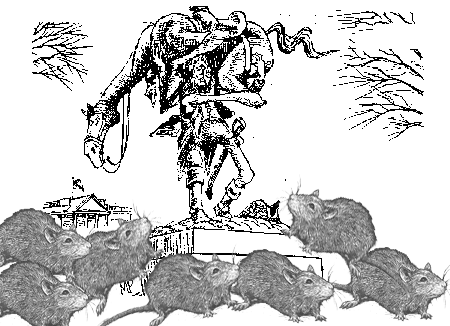Letter from William Thomas

Thomas
P.O. Box 27217
Washington, DC 20038
February 7, 1997
Mel Poole
Lafayette Park Manager
National Park Service
1100 Ohio Drive SW
Washington, DC
Dear Mr. Poole,
Yesterday I received your letter dated January 31, 1997. Judging from your observation that "rats are still abundant," I imagine your letter was prompted by my letter of November 15, 1996, which referred to newspaper and TV news reports about the rat population in Lafayette Park.
Although your letter made a number of interesting factual representations, it failed to reply to my simple suggestion:
"All you need to do is assign one of your regular park maintenance people to work from, say, noon to eight, and have him/her empty the trash receptacles at 8:00pm ... No food, no rats."
Instead, of explaining why you didn't think it prudent to empty the trash at 8:00pm, it
seems you have made some questionable representations and ignored some very basic realities. For example, while "President's Park (may have) an active rodent control program," the Park also has a robustly active rodent population.
Because you hypothecate rats "will continue to reinvade the Park," it seems you may not realize that what I'm referring to is a clan of rats which inhabits the center of the Park. Sure, you can say "rats are still abundant in the surrounding neighborhoods," but that ignores the reality of the mound under the equestrian stature of Andrew Jackson, located in the exact center of the Park, which is a warren of rat holes stretching to exits scores of feet away. Fact is, we're not talking about "invading" rats here, we're talking about a clan of "resident" rats.
Don't want to debate the habits of Norwegian grey rats, but I have diligently studied rat activity in the Park, on a daily basis, for a few years. With all due respect, from my personal experiences and observations I am sure that "this increased population is (not) a normal seasonal variation." Quite the contrary, the rat population in the Park has remained constant since the present infestation began several years ago, prior to that time it was rare to see a rat in the park. I have a theory that this infestation resulted from rat displacement after the destruction of a building at 16th and I St., but let's not allow my personal hypotheses to distract from the subject at hand.
While the Park may have "5 certified Pesticide Applicators who routinely monitor rodent populations and apply rodenticides," plainly -- as reported in the Washington Post and on TV -- the Park is still a bustling center of rativity. Likewise, despite your desires to "ratproof" trash containers, the fact remains that there aren't any 'ratproofed' trash containers in the Park. Similarly, the "removal of "overgrown vegetation ... to reduce rat harborage," appears to be a reference to trimming the hedges in the middle of the Park, however, whatever it refers to, even total vegecide in the Park won't discourage rats from nesting in their burrows.
You don't suggest that the Washington Post, or I, are imagining there are a remarkable number of rats observable in the Park. Indeed, your references to "rodenticides," "ratproofed trash containers," and "rat harborage" reduction efforts implicitly bespeaks a "rat problem" exists, lending your letter an apologist tone.
Because rats are little guys; "short" to us, is "long" to them. Essentially, they are territorial creatures, eating where they live, rather than commuting from "surrounding neighborhoods" to invade alien dining areas. Since you apparently realize that the Park Clan rats came to "the park in search of food and shelter," it's all the more difficult for me to understand why you don't just empty the trash cans at 8:00pm ... no food in the Park, no rats in the Park, either they'll migrate to new sheltered neighborhoods, or they'll starve.
Rather than impress one another with our intimate knowledge of the peaking "life cycle
of rats," we could even look at it from a more proactive protective point of view: Emptying the trash cans at 8:00pm would have a deterrent effect on any restive neighboring rat populations which might be plotting an invasion of President's Park.
At the risk of sounding critical, do you think that discussing specific methods of addressing a particular "rat population" would be more or less practical than discussing apologist theories in hopes of explaining the rat population away?
Sincerely,
Thomas

